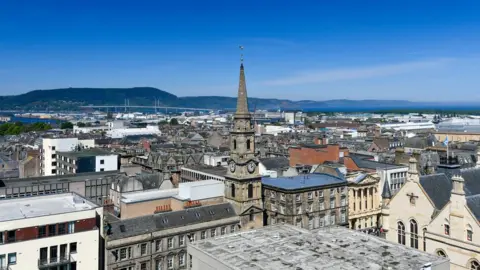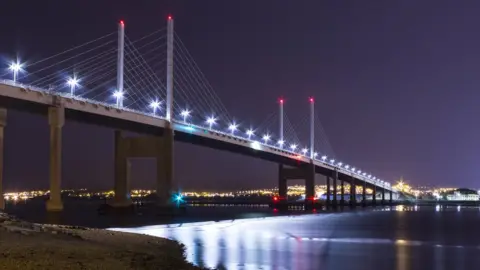Where and why earthquakes occur in Scotland
 Getty Images
Getty ImagesEarthquakes are rare in Scotland and when they do occur they usually pass unnoticed, but the potential for a large damaging quake is taken seriously.
In August 1816 an earthquake shook Scotland from the Pentland Firth coast in the north to Coldstream in the Borders.
A man walking in the hills near Relugas in Moray told of hearing a sound like a "rushing wind".
Furniture moved across floors in homes in Fraserburgh in Aberdeenshire while elsewhere church bells rang out and dogs started howling.
Inverness bore the brunt of the quake. Chimney tops and pieces of masonry fell from buildings and the Town Steeple was twisted out of shape. Ferrymen at a crossing between North Kessock at Inverness and the Black Isle told of their boat being rocked up and down as if by waves.
But Scotland's largest known earthquake came 64 years later, in November 1880.
The 5.2 local magnitude (ML) quake in Argyll was felt along the west coast of Scotland and out east as far as Perthshire.
Lighthouse keepers in Lewis and Barra in the Western Isles and from Cape Wrath in Sutherland to the Mull of Galloway reported feeling it.
Seismic 'swarm'
August 1974 saw a 4.4ML earthquake which had its epicentre in Kintail in the north west Highlands.
The quake was the largest in a "swarm" of more than 20 seismic events that occurred for several months into the following year.
 Getty Images
Getty ImagesBritish Geological Survey (BGS), which records seismic activity across the world, detects up 300 quakes every year in the UK.
Only about three of these events are usually felt by people or are heard as a deep rumbling sound or a loud bang.
In August last year, people reported windows rattling and house beams creaking during a small earthquake on the Isle of Skye.
On Tuesday this week people in the west of Scotland were shaken by an earthquake in the early hours of the morning.
The earthquake, with a magnitude of 3.3, according to British Geological Survey (BGS), happened just before 02:00.
BGS said its epicentre was at Achnamara west of Lochgilphead in Argyll and Bute.
More than 30 people reported the tremor, from as far away as Edinburgh and across Ireland.
Broken pelvis
BGS said larger quakes with the potential to cause minor damage, such as those in the past, occur about every 38 years.
In the UK, the most recent of these was a 5.2 magnitude earthquake was in February 2008 which was felt across England and parts of Wales. A man suffered a broken pelvis when a chimney collapsed in South Yorkshire.
And precautions are taken for these larger earthquakes.
For the first time in 10 years BGS has updated its seismic hazard maps for the UK.
It has been able to draw on larger data sets than have been previously available along with some new tools and methods to improve on its previous maps.
The maps show where seismic events of varying strength may happen, and with what probability. They are used by engineers to help them decide whether buildings and other structures need to be designed to be "earthquake resistant".
In Scotland, the Kessock road bridge and a nearby waste water pipe laid by Scottish Water have been designed to be "quake-proof".
 Getty Images
Getty ImagesBut why do earthquakes occur in Scotland?
Quakes are associated with a geological feature called a fault, which is a fracture or an area of fractures between two huge blocks of rock. During an earthquake there is a sudden movement between these blocks, such as one slipping down or up against the other.
In Scotland, these faults can run for hundreds of miles.
According to BGS, most Scottish earthquakes occur in western Scotland with events felt in places such as Islay in the Inner Hebrides and also Fort William and, in November last year, in Glen Coe.
In the Highlands, one of the most active areas, seismic activity is related to what are known as the Highland Boundary Fault Zone, Great Glen Fault Zone, Strathconon Fault, Kinlochhourn Fault and the Loch Maree Fault.
The Great Glen Fault is probably the best known of the fault zones. At least 300 miles (483 km) in length it cuts diagonally across the Highlands from Inverness to Fort William and has its origins in events that happened about 400 million years ago.
It is home to the world-famous Loch Ness, just down the road from Inverness and its now long repaired earthquake-hit town steeple.
